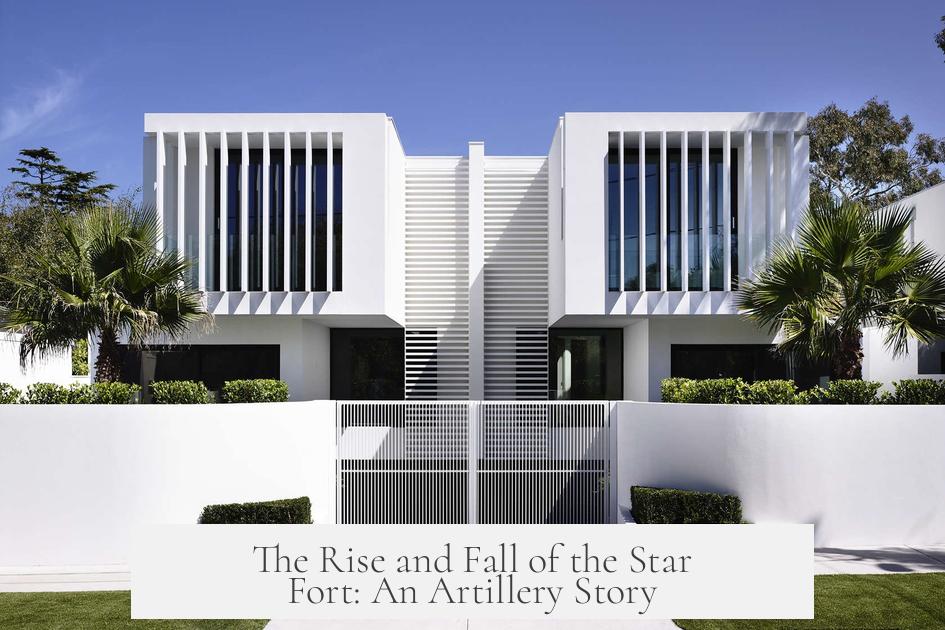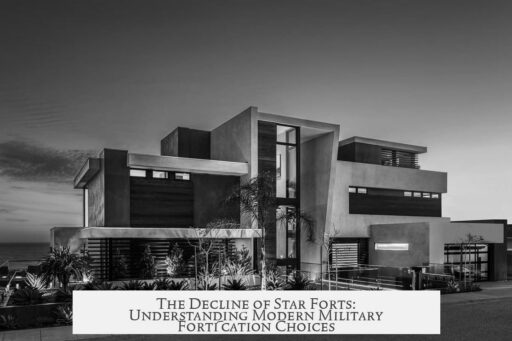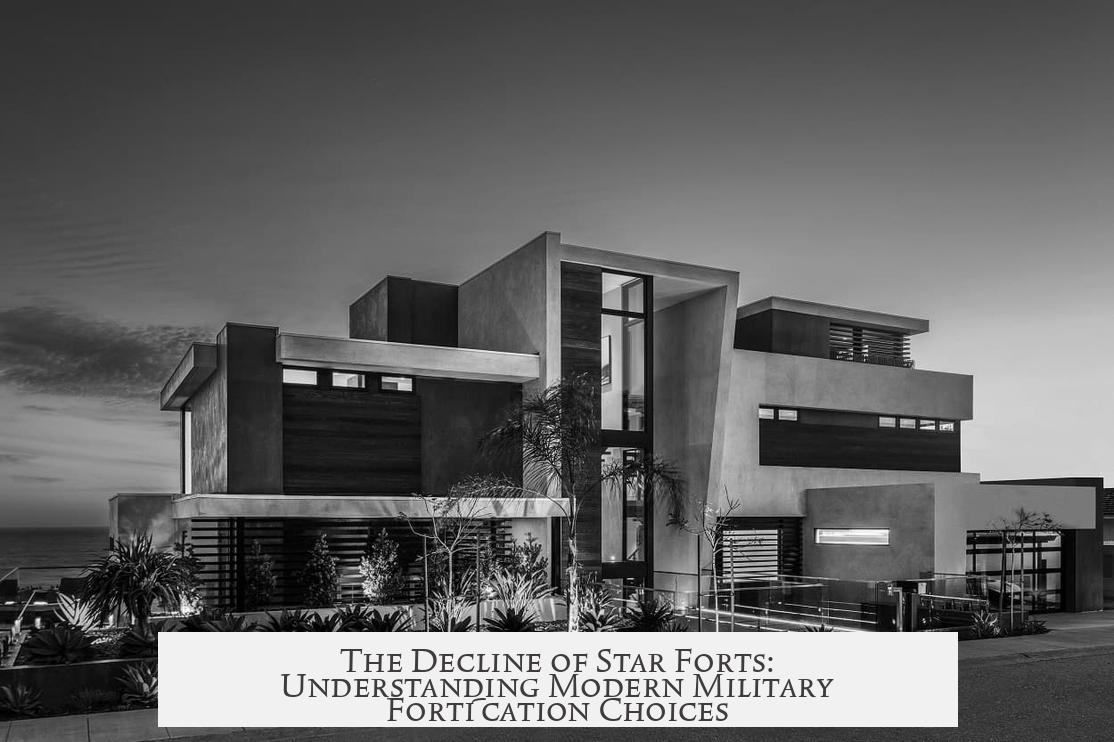Modern militaries no longer build star forts or elaborate fortifications because advances in artillery, mobility, and warfare tactics have rendered such structures obsolete and vulnerable. The evolution of weaponry, especially artillery, and the changing nature of war have demanded new defensive strategies that prioritize practicality, concealment, and mobility over impressive designs.
Star forts, which flourished from the 16th through the 18th centuries, were originally designed to withstand cannon fire and provide overlapping fields of defensive fire. Their complex geometric shapes, bastions, and ramparts allowed defenders to cover all angles and resist siege artillery of the time. However, starting in the late 1700s and progressing into the 19th century, the rise of rifled artillery and more powerful gunpowder weapons changed this dynamic.
Rifled artillery increased range and accuracy, enabling attackers to bombard fortifications from greater distances. This capability meant that fort walls, no matter how cleverly shaped, became vulnerable targets. For example, during the American Civil War, Union siege artillery could accurately hit Confederate forts from roughly a mile away, quickly neutralizing defensive artillery positions and breaching walls.
The advent of high-explosive shells further hastened the decline of traditional masonry forts. In World War I, the German use of massive mortars and howitzers, such as 380mm and 420mm guns, effectively shattered the earth and concrete of existing fortifications. The protection offered by thick brick walls was insufficient against these powerful explosives.
Modern artillery also fires in high arcs, targeting the roofs and inner structures of forts rather than their walls. This renders the star fort’s design less effective since it cannot defend against plunging fire that bypasses walls entirely. Consequently, fortifications began to move underground to gain better protection from direct hits and aerial observation.
By the 20th century, the philosophy of fortification shifted dramatically. Elaborate bastions and ornamental designs gave way to simple, polygonal forts often built underground or camouflaged to evade detection. Trench systems and defense-in-depth strategies replaced massive single-structure forts. These networks of interconnected strongpoints increased survivability and allowed for flexible, layered defense rather than relying on a single mighty fortress.
Mobility became another driving factor. Armies gained unprecedented ability to maneuver, and fast-moving units, like tanks and mechanized infantry, could bypass or isolate static fortifications. This showed the limitations of fixed defensive structures as strategic anchors. Military logistics and power projection evolved to favor easily movable depots and bases, allowing forces to reposition with advances or retreats rather than being tied to permanent positions.
In modern warfare, fortifications must be:
- Small and mobile to avoid detection and destruction.
- Often underground or hidden to reduce the risk of air and artillery attacks.
- Dispersed to prevent concentrated losses from precision strikes.
Aesthetics play a minimal role as survival and functionality dominate design choices. Investing in static, visually elaborate forts diverts resources from more effective weapons, vehicles, and technologies. Modern defense depends on the capacity to project force dynamically and avoid becoming a fixed target.
Exceptions exist, such as fortifications in certain colonial or remote territories, where star fort principles were adapted for specific conditions. However, these remain rare. Most contemporary defenses integrate stealth, mobility, and precision countermeasures that reject the traditional star fort model.
| Key Reasons Modern Militaries Avoid Star Forts: |
|---|
| Increased Artillery Range & Accuracy: Rifled guns effectively target static forts from long distances. |
| High-Explosive Shells: Explosives damage masonry walls beyond previous standards. |
| Arcing Trajectory of Artillery: Walls are less effective against plunging fire. |
| Shift to Underground and Dispersed Defenses: Enhances survivability against modern munitions. |
| Emphasis on Mobility Over Fixed Positions: Fast-moving forces can bypass stationary strongholds. |
| Resource Allocation: Modern militaries prioritize weapons, vehicles, and technology over ornate forts. |
Modern militaries prioritize fortification concepts that match current combat realities. They build secure, mobile, and often subterranean positions that blend with the environment. This approach focuses on sustaining forces and enabling rapid response rather than creating grand, permanent bastions. Star forts now serve educational or historical roles, highlighting a past era when artillery and war were fought under very different conditions.
Why Do Modern Militaries No Longer Build Star Forts or Fancy Fortifications?

Simply put: modern militaries don’t build star forts anymore because today’s weapons and warfare tactics have made them obsolete—beautiful but ineffective relics from a past era. Let’s break down why the big, spiky, star-shaped fortresses of Vauban’s time have been shelved in favor of stealth, mobility, and underground defense.
Star forts are undeniably stunning. Their sharp points, intricate bastions, and geometric beauty shaped military architecture for centuries. But looks only get you so far in war. As artillery and technology developed, these once mighty fortresses became easy targets and expensive burdens.
The Rise and Fall of the Star Fort: An Artillery Story

Back in the 1600s and 1700s, the art of war revolved around smoothbore cannons firing solid shot. These cannons weren’t exactly precision instruments. They shot heavy iron balls that mostly bounced and smashed into thick walls. Star forts thrived in this environment. To resist cannonballs, designers thickened walls and layered them with dirt. This dirt absorbed the shock, protecting the men inside. The bastioned star shape meant overlapping fields of fire defending every approach. A fortress that could chuck back cannonballs with a stylish flair.
But the 18th and 19th centuries rolled in with new firepower. Rifled artillery arrived—a game-changer with longer range, better accuracy, and shells that exploded on impact. Suddenly, thick walls made of brick or stone were less protective. The Siege of Fort Pulaski in 1862 dramatically proved this point. Rifled cannons opened fire from nearly a mile away, taking out Confederate guns and punching holes straight through the fort’s walls. That star design? It didn’t save the day.
High explosives further sealed the star forts’ fate. With arrival of massive mortars and howitzers—like the German 380 mm and the infamous Big Bertha—forts once thought impenetrable cracked and crumbled. The Battle of Liège in WW1 illustrated this in vivid detail. Concrete and earthworks that had seemed solid were shattered. It was clear: glowing high explosives laughed at masonry and bragged about destruction.
Walls Fire Back—But Not in a Good Way

Here’s a detail that often goes unnoticed. Modern artillery shoots in arcs. High-angle fire lets shells come down vertically, hitting tops of walls and exposed surfaces. A star fort’s walls, once an obstacle, now just became convenient targets. Instead of protection, walls glorified destruction. Modern warfare demands something sturdier—or better yet: hidden.
Modern Fortifications: The Shift Underground and Into Networks

With this evolution, fort design took a sharp left turn. Elaborate bastions gave way to simpler polygonal forts, often built underground or with reinforced concrete. Defensive networks replaced single strongholds. Imagine several bunkers spread out, connected by tunnels and radio—not a majestic star but a spiderweb of survivability.
Examples like the forts around Liège in WW1 still hold some star fort DNA, like overlapping fields of fire, but many defenses moved deep underground. Artillery pieces weren’t perched on walls any longer; they retracted inside for protection. Comfortably hidden, these forts could withstand heavier bombardments.
Why the underground obsession? Because modern munitions penetrate and explode above-ground structures like paper. Protection now means being invisible and buried beneath meters of earth and concrete—much less glamorous, but far more effective.
Logistics and Mobility: Fortification’s Modern Challenge

The meaning of “fortify” changed alongside improvements in transportation. In the 17th century, armies depended on local supplies. A single fortress blocking a key road or river could dominate a region. Star forts fit this strategy well.
Enter the age of railways, trucks, and air transport. By the 19th and 20th centuries, armies resupplied faster and moved around obstacles. Forts blocking a route no longer guaranteed victory. Enemies simply bypassed or surrounded them.
So, fortification shifted from static, huge bastions to dispersed networks of smaller, underground forts connected by communication lines. Mobility became king. Fixed forts are sitting ducks if the enemy can fly over or circle wide. Mobile forces, meanwhile, engage and retreat as needed, limited only by fuel, ammunition, and the soldier’s gumption.
Lessons from World Wars: The Death Knell for Fancy Forts

WW1 confirmed that star forts and similar designs belong in history books. Artillery shells firing in arcs made walls pointless. Trench warfare and defense-in-depth became the norm. Defense moved from grand fortresses to cleverly designed trenches and networks.
Then WW2 sealed the deal with mechanized warfare. Tanks and aircraft moved fast, bypassing or breaking fort lines—think of the Maginot Line, famed for being outflanked rather than breached. Speed and adaptability trump static defenses. The future was mobile defense and flexible response.
Shifting to Practicality Over Aesthetics
Let’s be honest: warfare prioritizes survival and efficiency, not beauty. Modern forts need to be small, mobile, and often stealthy. They hide underground or camouflage with natural terrain. Being conspicuous means being a target, especially from air or satellite surveillance.
Dispersed defenses avoid catastrophic destruction. Instead of one big fortress, you get many small strongpoints working together. Each one might be ugly or plain, but together, they form a resilient shield—which is far more important than looking like a Renaissance painting.
Some Exceptions: Star Forts Evolve, Not Vanish
Occasionally, star fort elements persist, especially in colonial or remote theaters, like French fortifications in Africa. But these are the exceptions, not the rule.
Modern fortifications focus on countering new threats: precision-guided munitions, aircraft, and electronic surveillance. Mobility, stealth, and survivability now outweigh grandeur and geometry.
What Can We Learn Today?
- Technological advances reshape military architecture relentlessly.
- Fortifications must adapt or become obsolete.
- Beauty rarely beats effectiveness in war.
- Successful defense combines mobility, intelligence, and adaptable infrastructure.
- Historical designs offer inspiration but not necessarily modern solutions.
Final Thoughts
Why no more star forts? Because war evolved, and star forts did not keep up. Their intricate shapes and towering walls once defined what it meant to be “fortified.” But modern weapons, from rifled artillery to precision bombs, turned those designs into easy targets. Forts went underground; defense became networks instead of monuments.
Military strategy now values flexibility, speed, and stealth more than aesthetics or imposing stone walls. The star forts of old are fascinating history, but modern defense looks quite different—quiet, subtle, and designed to survive the next generation of threats.
Wouldn’t it be fascinating to see a star fort designed for modern war? One with stealth coatings, underground tunnels, and drones flying overhead? For now, though, modern militaries are content leaving the stars to the sky.




